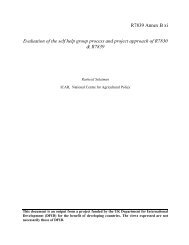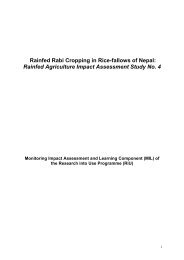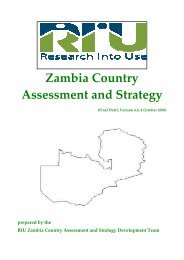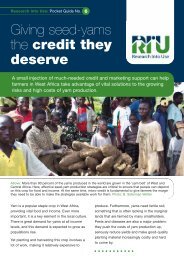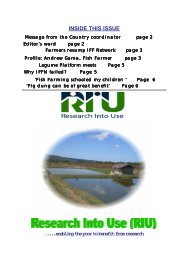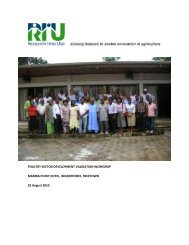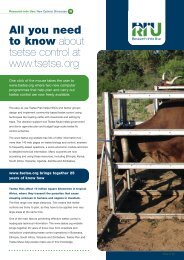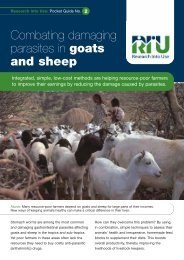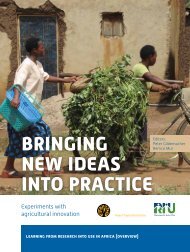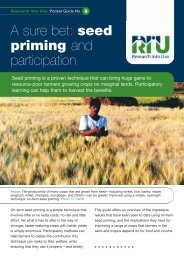Profitable pulse crops transform rice fallows RIU Pocket Guide 8
Profitable pulse crops transform rice fallows RIU Pocket Guide 8
Profitable pulse crops transform rice fallows RIU Pocket Guide 8
Create successful ePaper yourself
Turn your PDF publications into a flip-book with our unique Google optimized e-Paper software.
Research into Use: <strong>Pocket</strong> <strong>Guide</strong> No. 8<br />
4<br />
Growing <strong>crops</strong> in <strong>rice</strong> <strong>fallows</strong>:<br />
the practicalities<br />
Start the process with farmers<br />
It's been found that the best way to<br />
introduce farmers to <strong>pulse</strong>s as a fallow crop<br />
after monsoon <strong>rice</strong> is to find a small group<br />
of interested farmers and work with them.<br />
Each farmer needs to agree to plant <strong>pulse</strong>s on<br />
part of his/her land. If possible, the plots should<br />
be next to each other and about 2-3 hectares in<br />
all. This makes it easier to protect the trial plot<br />
from grazing animals.<br />
Work towards getting early<br />
<strong>rice</strong> harvests<br />
The earlier <strong>rice</strong> can be harvested, the<br />
earlier the follow-on crop can be sown.<br />
Early harvests mean that more moisture remains<br />
in the soil for the next crop. Early-maturing<br />
varieties, developed in partnership with farmers,<br />
are now available that can bring the <strong>rice</strong> harvest<br />
forward by ten days or more. This makes a big<br />
difference. Another way of bringing the harvest<br />
forward is direct seeding where, instead of<br />
transplanting <strong>rice</strong> seedlings, <strong>rice</strong> is sown directly<br />
into paddies. In this case, more resources need<br />
to be spent on weeding.<br />
Conserve soil moisture<br />
It's important to keep as much moisture in<br />
the soil as possible. This means minimum<br />
tillage—quickly preparing the soil for sowing<br />
without too much disturbance.<br />
Treat seeds before sowing<br />
'Priming', that is soaking seed overnight,<br />
helps seed germinate and gives seedlings a<br />
head start. After priming, the seeds need to dry<br />
just enough to be sown easily. Soaking chickpea<br />
before sowing costs practically nothing yet has<br />
proved outstandingly effective in many places,<br />
including northwestern Bangladesh.<br />
Seed priming is easy, low-cost, low-risk<br />
and very effective<br />
Soak seeds for 4-6 hours in water. For each<br />
kilogram of seed, add 0.5 g sodium<br />
molybdate in 1 litre of water and 5 g<br />
Rhizobium inoculum in 1 litre of water.<br />
Adding Rhizobium to the soaking water<br />
helps the seedlings form nitrogen-fixing<br />
nodules which capture nitrogen from the air.<br />
This is especially true where soils are acid,<br />
which is often the case in <strong>rice</strong> paddies.<br />
Molybdenum is an essential micronutrient<br />
for chickpea. Tiny amounts of molybdenum<br />
improve Rhizobium nodulation.<br />
Soaking seed in water alone dramatically<br />
improves germination. But, priming seeds<br />
with both molybdenum and Rhizobium (as<br />
above) raises yields by a third compared to<br />
priming with just water.<br />
Choose <strong>pulse</strong> varieties that<br />
mature early<br />
The varieties for follow-on <strong>pulse</strong> <strong>crops</strong><br />
need to flower and set seed early. This is<br />
because they need to be ready to harvest in<br />
75-80 days—before they have used up all the<br />
soil moisture. Normally chickpea takes 120<br />
days to mature.



